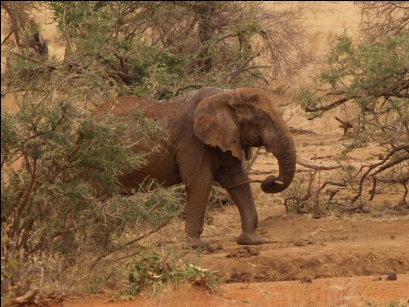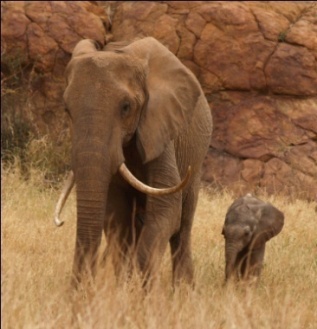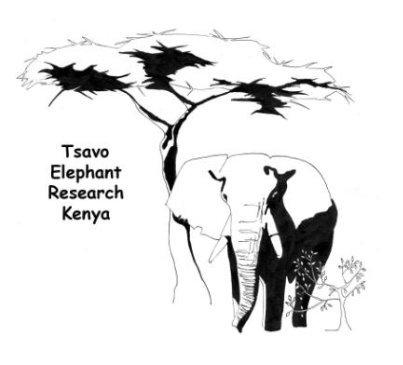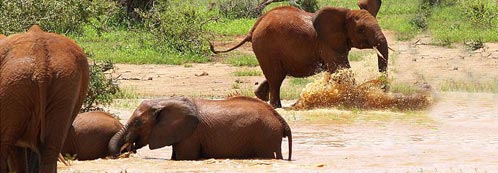Field Notes
January - April 2013
It was hot and humid between January and February with green vegetation and there were a few patchy rain storms. Most of the waterholes in the bull area were partially full while others were dry. Raines started in late March and continued through April with high temperatures and humidity. In mid-April it rained for three consecutive days. By the end of April all the waterholes were overflowing and the vegetation was green, tall and thick.
The large flocks of Barn Swallows and Eurasian Rollers that arrived in late 2012 remained in Tsavo until mid-March. With abundant resources Eland, Zebra, Buffalo, Fringed-eared Oryx, Hartebeest and Gazelle aggregated and there were several newborns of each species. A newborn Fringed-eared Oryx with the umbilical cord still attached was running around a group of Oryx and Hartebeest. The lone Topi in the bull area was again sighted with a group of Hartebeest and Gazelle. Many groups of Ostrich, with chicks of all ages, were plucking the white blossoms from Bauhinia shrubs.
Bulls
Bull groups ranged from two to eight bulls from January to early March. With the rains in mid-March many known bulls moved out of the bull area and the few that remained were alone or with one or two associates. Many small groups of newly independent males, 10-15 years old, were in the bull area. Both Skylight and Sunray left the bull area in January. When they returned in March, Skylight had broken-off a tip of his left tusk. Then in April, Sunray had broken the tip of his right tusk. They may have broken the tusk- tip while they were digging for tubers or minerals in the soil.
Darwin was in musth in mid-March with a family resting under a large Acacia. Two young bulls approached them and the young female, 15-16 years, rumbled and moved closer to Darwin. Each time the bulls tried to get close Darwin rumbled and the bulls backed away. A few days later Darwin was alone, still in musth, pulling down branches of a Delonix tree. A week later he was still in musth heading north with a young male, 10-12 years old, following him.
In early March Sandstone was feeding on vines and herbs with two young males. Four days later, he was in musth with a family. Eight days later he was moving, with purpose, through an open glade followed by a young male (14 years old). His temporal glands were more swollen with fluid draining past his jaw, his penis was dribbling, and he held his head high and alternated his ear flaps. As he crossed the road in front of me he stopped, looked at me, rumbled, and then continued heading east. This was the first sighting of him in musth.
Families
Bulls are typically described as joining a family creating a mixed-sex group, but I often see the reverse, families joining a bull or bull group. In February, Livingstone was with Tiberia’s family feeding in an open grassland habitat. As Livingstone moved away from the family through the bush from waterhole to waterhole getting a drink or splashing the family followed him. It was a very hot day and when Livingstone moved to the shade of a tree the family followed. As they approached him, he shifted next to the trunk of the tree and the family moved under the shade close to him. Once everyone was under the shade and settled, a young male (4-6 years old) moved around the family and stood next to Livingstone, who placed his trunk on the calf’s back. They rested that way for about 15 minutes until Livingstone removed his trunk and placed it on the ground. The calf moved closer to Livingstone until he was touching his hind leg. They rested close together for 40 minutes, until Livingstone decided to move from the tree to feed and the family followed.
In April, Evergreen’s family was with Thorn (a bull 24 years old) drinking from a waterhole. When the family moved away from the waterhole they stopped and stood in a tight bunched group. Evergreen rumbled and Thorn rumbled in response, but continued to drink and splash water behind his ears. It appeared that the family was waiting for Thorn to join them. Finally when Thorn left the waterhole the family joined him, rumbled and moved off into the thick bush.
May - September 2013
With the heavy rains in April many waterholes contained drinking water in some areas until early August. Although most of the vegetation was dry by July, the vegetation surrounding the hills remained green during the dry season, where many elephants and other wildlife gathered. In September the temperature and humidity began to rise indicating the rains might be early this year.
Many species, small and large, use elephants trails to and from a waterhole. In late August I was waiting for a group of bulls to cross an open area so I could see their ears to identify them, when eight buffalo followed by a group of zebra started walking along an elephant trail to a waterhole. They stopped and snorted and when I looked along the trail I saw seven lions sitting adjacent to the trail watching them approach. The buffalo and zebra bunched close together watching the lions. After a short while a signal must have been given among the buffalo because as a group they ran toward the lions. The lions ran away as the buffalo ran along the trail. The zebra decided not to follow the buffalo and they ran in the opposite direction. By the time the elephants finally crossed the road the lions were gone and all was quiet again
Bulls
Sandstone, Skylight and Darwin were in musth in May. Sandstone was following a family of six, but they moved so quickly through the bush that I lost them as soon as they crossed the road, although I could hear rumblings. A few minutes later Skylight was chasing a female in a family, running in the same direction as Sandstone, across the road and out of sight. On the same day, Darwin was guarding a lone female with five young bulls nearby. Sunray was 200 meters away watching. When Darwin started to move toward a waterhole leaving the female behind, Sunray approached but when Darwin stopped, flapped and extended his ears Sunray backed away. While Darwin was interacting with Sunray, one of the younger bulls approached the female, but when she rumbled, Darwin quickly turned and returned to the female and the young bull backed away. When Darwin again moved toward the waterhole this time the female followed. A buffalo was resting at the edge of the waterhole and when Darwin approached he swung his single right tusk at the buffalo and it crashed into the horns of the buffalo, sending the buffalo away.
I was collecting data on bulls within an aggregation of more than 200 elephants when there was movement behind my vehicle, a female and her calf were running across the road with a musth bull close behind and since he was focused on her he paid little attention to me. He finally caught up with the female, mated and I could hear trumpeting at the base of the hill. Meanwhile there was more rumbling and trumpeting by another pair mating 400 meters downhill.
In June there were eight lions resting under an Acacia near a waterhole next to a major elephant trail when a group of five bulls approached. The two older bulls turned toward the lions, flapped their ears and then continued to walk along the trail.
 The three younger bulls, stopped, extended their trunk toward the lions, side-stepped away then ran to catch-up with the older bulls at the waterhole. The lions never moved. When the bulls left the waterhole, following the same trail, the lions were still there and the bulls repeated the same behaviors as they headed north.
The three younger bulls, stopped, extended their trunk toward the lions, side-stepped away then ran to catch-up with the older bulls at the waterhole. The lions never moved. When the bulls left the waterhole, following the same trail, the lions were still there and the bulls repeated the same behaviors as they headed north.
In late-July, Livingstone was leaving a waterhole tossing soil on his head and back with his trunk. As he walked along an elephant trail, he stopped picked-up a branch, balanced it horizontally on his trunk than turned the branch and scratched his leg and chest (photo left). This is the second time I’ve seen him use a branch as a tool to scratch.
Families
In mid-June Athena’s family had just left a small waterhole heading toward the base of a hill, where there were a few green shrubs to eat and trees that provided shade. Athena moved toward a large Acacia and the family followed. Once they were all in the shade, one by one, the three young calves laid down to sleep. Also in June a family was feeding in an open grassland habitat when a female calf, 3-4 months old attempted to get close to an adult female that was not her mother. The female repeatedly moved away but the calf followed. Finally the female stopped turned quickly, lowered her head and flapped her ears. The calf stopped and three juveniles in the group moved quickly surrounding the calf preventing her from getting close to the female. When her mother joined them she put her trunk over her calf’s back and pulled her close. Once the calf was with her mother, the adult female walked away.
 On the 2nd of July Eldora’s family was at the base of a hill feeding on shrubs and Skye (Eldora’s daughter) had a female newborn (photo right). She had a white coating (dried amniotic fluid) over her body which means the calf was a few days old. Several times over the next few months I saw Eldora’s family and each time the newborn was progressively stronger. In September they were with a bull, Monsoon, who was pulling down branches to eat and the family was eating the branches that fell to the ground. On numerous occasions the newborn moved toward Monsoon who stepped away. Bull behavior near a calf, especially a very young one, is typically careful and gentle
On the 2nd of July Eldora’s family was at the base of a hill feeding on shrubs and Skye (Eldora’s daughter) had a female newborn (photo right). She had a white coating (dried amniotic fluid) over her body which means the calf was a few days old. Several times over the next few months I saw Eldora’s family and each time the newborn was progressively stronger. In September they were with a bull, Monsoon, who was pulling down branches to eat and the family was eating the branches that fell to the ground. On numerous occasions the newborn moved toward Monsoon who stepped away. Bull behavior near a calf, especially a very young one, is typically careful and gentle
In mid-August Holda’s family and Hazel’s family were together with a 20 year old bull, feeding in an open grassland habitat. As he moved forward both families followed.
October - December 2013.
It rained heavily in some areas in early October, but the vegetation and waterholes in other areas remained dry. In October a second Topi moved into the bull area. The male stays with a group of Hartebeest and this new one, a female, was 5km to the north. Widespread rains started on the 24th of November and by the end of the month all the waterholes were full and the vegetation was green. The rains continued through December and many waterholes were overflowing creating small lakes. The lions that are often in the bull area were again found in groups of 2-6 individuals. Large flocks of Barn Swallows arrived in Tsavo in late November and Eurasian Rollers arrived in early December. Chestnut weavers, a seasonal rain migrant, gathered in flocks of more than a hundred birds, surrounding Mzinga Hill.
Bulls
With the early rains in October, finding known bulls was a challenge since most of them left the bull area and moved to areas with green vegetation and full waterholes. A few bulls remained in the bull area where the vegetation was green but the waterholes were dry. When the rains started in late November and were widespread most of the bull group consisted of newly independent males.
When bulls rest under the shade of a large tree they lean on the tree trunk or draping their trunk over a low branch, but sometimes they lie down. Moonlight, a 20-24 year old bull was resting under a tree with a large bull (30-35 years old). The older bull was leaning on the tree while Moonlight was leaning on him. The older bull shifted forward and Moonlight woke up, moved a few steps away and then lay down. I watched them for 35 minutes until the older bull flapped his ears, Moonlight got up quickly and they both moved away from the tree in the sunlight and began feeding.
Livingstone and Sun moved out of the bull area in October, south of Voi River with the early rains. This is the area Livingstone often moves to every year during the wet season. Darwin, Sandstone, Dusk and Skylight, who are close associates, remained in the bull area until late-November
Families
Many families moved to areas with abundant resources when the localized rain started in October. In these areas families and bulls aggregated in groups of more than 100 individuals and within these aggregations many newborns were recorded. However, some families decided to stay in their dry season range, where vegetation was green but the waterholes were dry. Athena’s family and Miranda’s family stayed in their dry season range until the wide-spread rains started in November. These two families have similar seasonal ranges; northwest during the dry season and south to Voi River during the rains.
In November, Eldora’s family was with Saturn and two large bulls, feeding, in an open grassland habitat. Skye’s new calf was curious about the bulls. She approached them, extended her trunk, then quickly run back to be near Skye. In the past Eldora’s family and Tessa’s family were often together, but I haven’t seen Tessa’s family for many months. She may have decided to move to areas with more resources.

Tsavo Elephant Research Needs Your Help.
Donations are needed to continue this 30+ year field study
and support a Kenyan research field team.
We monitor the behaviors of Tsavo known bulls and families:
group dynamics, offspring & survival, musth cycles and habitat use.
Please click here or on the donate button
to send your donation.
Thank you!
Barbara
